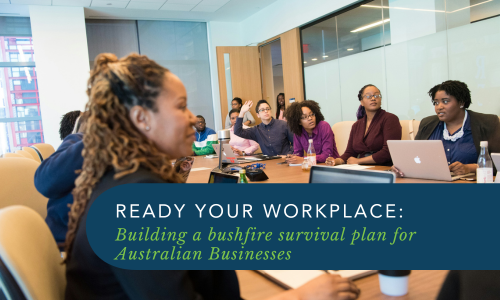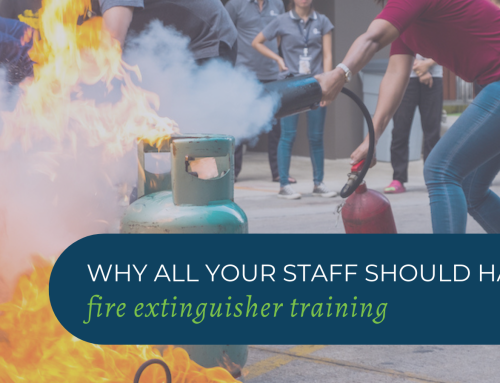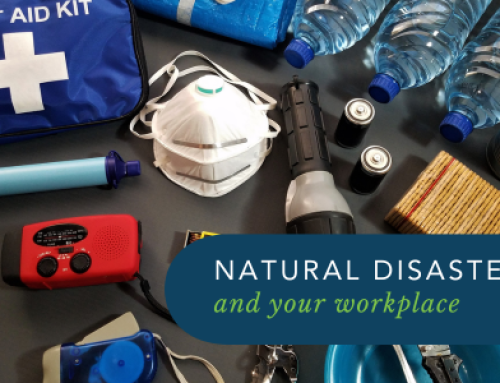Bushfires are an unsettling reality for many Australians, posing a significant threat to communities and workplaces alike. While preparing for the unexpected can feel daunting, proactive measures can make a major difference in protecting personnel, property, and business continuity. This blog explores some key steps building a bushfire survival plan to strengthen your workplace’s resilience against bushfire threats in Australia.
Plan and Prepare:
The foundation of bushfire preparedness is a comprehensive bushfire survival plan. This article will outline procedures for different scenarios, assigning roles and responsibilities to ensure everyone knows what to do. It is also practical to regularly review and update the plan, considering feedback from staff members and incorporating local fire authority or external consultant recommendations.
Know Your Risks:
Understanding your location’s bushfire risk is crucial. Consult fire danger maps from your local fire authorities (E.g. For NSW – Rural Fire Service and Fire and Rescue NSW) and assess potential threats to your workplace. Analyse and assess relative factors like flammable materials, vegetation proximity, and access points for emergency services. Leaving early is always the best option before a bushfire danger actually impacts your workplace or home.
Fireproof Your Premises:
Reduce fire hazards around your property. Clear flammable debris especially along pathways and close to the building, trim overhanging branches, and keep gutters free of leaves. Consider fire-resistant landscaping and install ember guards on vents and openings. Another suggestion is to ensure gas cylinders and flammable liquids are securely stored away from potential ignition sources.
Protect Essential Equipment:
Identify critical equipment and operations, prioritising those essential for business continuity or containing potential hazards. Develop clear procedures for safely shutting down processes to minimise damage and ensure employee safety. Protect valuable assets from smoke and heat damage. You can do this by moving them to fire-resistant areas or covering them with protective materials. Implement a data backup strategy with regular backups and even consider storing copies off-site. This layered approach safeguards your critical resources and minimises operational disruptions during and after a bushfire event.
Communication is Key:
Establish clear communication protocols for emergencies. Appoint a communication leader, set up reliable communication channels like text message alerts, download emergency apps such as Hazards Near Me and ensure everyone has access to essential information about the facility (E.g. location of Assembly Areas). Regularly test communication systems and practice using them during drills.
Equip and Protect Your People:
Provide personal protective equipment (PPE) like masks, goggles, gloves, and water for staff to protect themselves from smoke and embers. This could be a Bushfire Survival Go-To bag that could be kept in a common and easily accessed area. Train staff on fire safety procedures, including extinguisher use and evacuation protocol. Encourage staff to stay informed about fire risks and emergency warnings.
Prepare an Evacuation Plan:
Identify evacuation routes and designate safe assembly points clear of potential fire hazards. Ensure everyone knows their designated roles and responsibilities during an evacuation. Practice drills regularly to familiarise staff with the process and address any concerns. In a bushfire, this evacuation plan may include location of an established community evacuation centre.
Do not Forget the Aftermath:
Bushfire recovery requires planning too. Develop a post-fire recovery plan detailing steps for assessing damage, contacting insurance, and resuming operations. Consider staff well-being by offering support services and resources to manage stress and trauma.
Beyond the Basics:
Consider smoke exposure risks: Implement air filtration systems and provide respiratory protection during smoke events. Train staff on the health risks of smoke inhalation and develop procedures for working safely in smoky conditions.
Stay informed: Regularly monitor fire danger warnings and updates from emergency services. Subscribe to local alerts and stay connected to official information sources.
Engage with the community: Build partnerships with local fire authorities and emergency services. Participate in community initiatives and contribute to collective bushfire preparedness efforts.
Remember:
Preparing your workplace for bushfires is an ongoing process. Continuous planning, training, and adaptation are essential for building a resilient organisation. By taking these proactive steps, you can create a safer environment for your employees, protect your property, and minimise business disruption during and after bushfire events.
Additional Resources:
Australian Bureau of Meteorology: https://www.bom.gov.au/
National Bushfire Information Hotline: 1800 240 670
Rural Fire Service NSW: https://www.rfs.nsw.gov.au/
Hazards Near Me: https://www.nsw.gov.au/emergency/hazards-near-me-app
By working together and taking preparedness seriously, Australian businesses can weather the storms – literally and figuratively – and emerge stronger in the face of bushfire challenges.
GET IN TOUCH
Are you ready for peace of mind that your workforce is as safe and prepared as possible?
With a dedicated team of staff ready to help you meet compliance requirements and improve the overall safety of your workplace, all you need to do is get in touch.
Request your free audit today!



